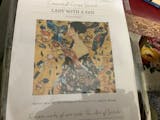Eugène Delacroix (1)
Eugène Delacroix (1798–1863) was a French Romantic artist, celebrated for his dramatic and emotionally charged paintings that broke away from the restrained style of Neoclassicism. His works are marked by vibrant color, energetic compositions, and an emphasis on emotion and movement. Delacroix’s influence on art extended far beyond his lifetime, inspiring Impressionists, Post-Impressionists, and modern artists.
Delacroix’s most famous painting, Liberty Leading the People (1830), commemorates the July Revolution in France. It depicts Liberty personified as a woman leading the people with a tricolor flag in hand, inspiring unity and rebellion. The painting became a symbol of freedom and democracy but was considered politically provocative and hidden from public view for several years.
Delacroix was a pioneer in using bold, contrasting colors to evoke emotion and energy. He believed that color should take precedence over line in a painting, a revolutionary idea at the time. His theories on color influenced later artists like Vincent van Gogh and the Impressionists.
Despite his public acclaim, Delacroix was intensely private about his personal life. He never married, though he had several romantic relationships. His private journal, published posthumously, offers insight into his thoughts on art, philosophy, and daily life.







